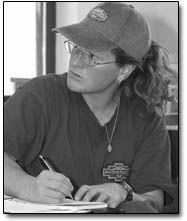 |
Shawna Legarza, superintendent
of
the San Juan Hotshots, collects firefighters’ credentials
Sunday at crew headquarters./Photo by Todd Newcomer. |
Shawna Legarza’s first
day on the job as a hotshot superintendent put her in the hot
seat.
For seven weeks, Legarza was training the new San Juan Hotshot
crew while the Missionary Ridge Fire burned less than 30 miles
from the crew’s guard station. When those training weeks
were over, there wasn’t any time for reflection, rest
or reprieve. Immediately, Legarza led her 19 hotshots into the
rough, backcountry terrain to begin digging fire lines and removing
fuels from a fire that had already taken its toll on a stressed
community.
Fortunately, she says, her 15 years of wildland firefighting
experience prepared her for walking into such a massive event.
“I just kept remembering that you can’t let the
emotions get to you,” Legarza says from her office at
the Engineer Guard Station. “You still have to do what
you have to, because Mother Nature is ultimately in control.”
While the fire raged on, Legarza had to evacuate her own home
in the few days she and the hotshots had off. Immediately after
working on the Missionary Ridge Fire, the hotshots were dispatched
to a Wyoming fire. For Legarza, who was leading a team of firefighters
with various years of experience, this was the norm. The only
difference was, she was in charge of her own crew now –
and one of only three women in the history of the hotshots program
to do so.
This year, Legarza is the only female superintendent of a hotshot
crew, of roughly 80 hotshot crews working for the Forest Service,
Bureau of Land Management, Park Service and Bureau of Indian
Affairs. Yet Legarza feels that she’s just another firefighter
who learned to love physical labor at a young age – and
then transformed that into a career that requires it.
Legarza grew up at the base of the Ruby Mountains in Elko,
Nev. Her parents owned a cattle ranch, on which she and her
brother were expected to pull their weight. After high school,
Legarza left Elko to study exercise physiology at the University
of Nevada Las Vegas. During a summer break, she applied to work
as a firefighter on an engine crew for the BLM. She didn’t
have any intent to start a career as a public lands firefighter.
But each summer, she found herself working at the same seasonal
job.
Before long, Legarza finished her undergraduate studies, went
on to get teaching certification and spent six months student
teaching in New Zealand, only to return to work as a firefighter.
She received her master’s degree in science and kinesiology.
Still, though, she was back working as a firefighter for either
the BLM or Forest Service.
“It’s a unique job. I really liked the adventure
of it. But I wouldn’t say I fell in love with it,”
Legarza says.
After working on helitack and engine crews, in 1991 Legarza
became a member of the Black Mountain Hotshots, based in Carson
City, Nev. She stayed on the job until 1997, when she became
a crew boss on a Type II team in Fairbanks, Alaska, and later
as a hotshot for the North Star crew.
Though she always thought she’d enjoy having her own
crew, it wasn’t Legarza’s single goal in her inadvertent
firefighting career. When the superintendent job of the new
San Juan Hotshots became available, Legarza saw it as her opportunity
to apply and share her years of experience. She didn’t
bat an eye at the fact that she was a woman, nor did she expect
to be treated differently because of it.
“I just do the job,” she says. “I don’t
feel like I need to make a statement about it.”
It isn’t the defining moment of her career, either. Instead,
that moment came in the form of an urban setting.
In the aftermath of Sept. 11, 2001, when New York City’s
World Trade Center buildings fell at the hands of terrorists,
Legarza’s Type I Incident Command Team in Alaska was called
to duty. More often, federal agencies are turning to Type I
incident command teams from the various public land agencies,
because, Legarza says, they have proven that their strategies
for working on national disasters are valuable.
In New York, she and her fellow crewmembers worked for a month
at Ground Zero, tagging remnants they found as they shuffled
through the rubble.
“That experience had way, way more of an impact on my
life than any fire I’ve ever worked on,” Legarza
says.
– Amy Maestas

